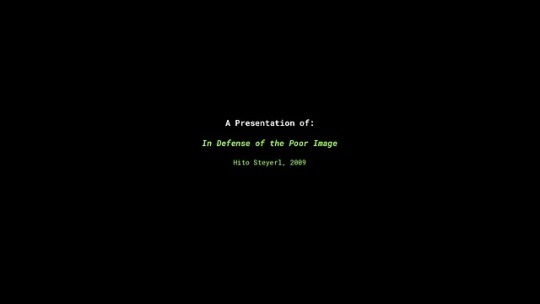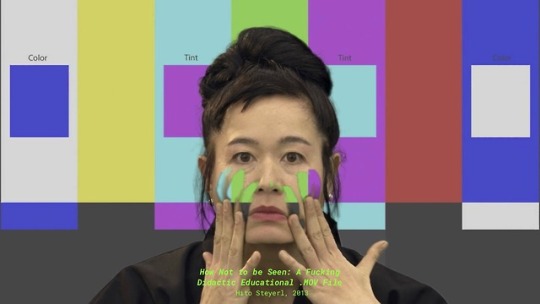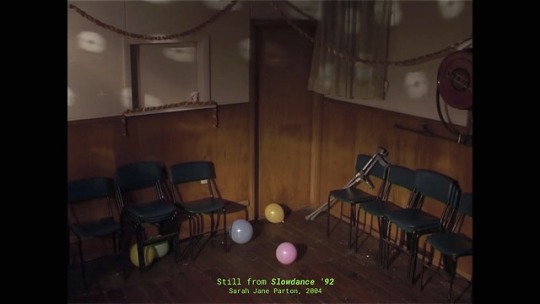Don't wanna be here? Send us removal request.
Video
youtube
this final video that will accompany my webcams for presentation! oveall i’m very happy with it. it will loop for the presentation. i took the feedback on board and added as many webcams as i could find that i enjoyed looking at and related to my concept of visuality.
0 notes
Video
youtube
Ann suggested I test an extra element to my work, which could be the inclusion of the curator of the videos/webcams (me) and how my decisions operate.
I chose to video my hands interacting with my device, in this case my laptop. I navigate to the insecam website and open a webcam.
as this is my first test, I have uploaded my development videos as I make them which I think is needed in order to see if this is working.
youtube
in this second test, i developed further by having the webcams preloaded and exploding the desktop screen so that all of the windows could be seen simultaneously. i wanted to achieve the affect of the classic surveillance/security footage view of the controller - example attached below.
i showed this video in class and got excellent feedback! everyone enjoyed it and said it added a lot to the webcams. someone mentioned maybe i should exaggerate the amount of cameras i load up, so it really does resemble someone who is surveilling as much as they possibly can. i think this will be my next test and a possible final video to accompany the live webcam presentation as it will add an extra dimension to the work.

0 notes
Text
sound
as i stated earlier, in my first test presentation of the webcams on singular computer screens the experience was elevated with sound that related to the video. some webcams have sound, but some do not. I have been sourcing my sound from freesound.org which has free to use under creative commons sounds and audio.

0 notes
Video
youtube
another nod to the act of surveillance and reclaiming the original intention of the surveillance back into the sphere of public eye and art. this is the opening sequence of "Der Riese" ("The Giant"), an 82-minute "City Symphony" by Michael Klier, 1982-1983, entirelly composed from material generated by surveillance cameras. The first sequence shows an airplane being monitored as it lands at the Berlin-Tegel airport.
I really enjoy this as I have found my own live feed from an airport in the Canary Islands:
youtube
1 note
·
View note
Video
youtube
the act of surveillance has been commented on for many years, such as in Alfred Hitchcock’s 1954 film Rear Window. I specifically love the quote, “Those are just a few of my neighbors. First I watched them just to kill time, but then I found I couldn’t keep my eyes off them - just as you won’t be able to.” I relate this to the act of the banal voyeur - watching constantly as “nothing” unfolds before their eyes, waiting for something to unfold.
0 notes
Text
testing
here’s a test of presentation for the webcams. the ones on display are the second experiment, the desired locations i want to travel to. im leaning towards presenting them for final display as i love the sublime-like view into windows and views of worlds that look dystopian. i also tested with sound effects to add an atmospheric touch and i’ll begin looking for free to use sound effects for presentation.




0 notes
Text
third experiment
seeing as the webcam surfing allows me (and anyone with internet and a device) to see anything that is live, it enables the viewer to see into places that are restricted. restricted in the sense that they could be... an industrial plant, a factory, a greenhouse, a Muslim only mosque...
the third experiment is thus access into webcams where you could not physically access the places they watch.







1 note
·
View note
Text
recording
so far i have been documenting the live feeds by screen capture methods, with the intention of making a video work for final presentation. copyright usage of cctv footage in new zealand has been hard to pin down, and its hard to know if i would need to follow the copyright law from the country of origin for each camera... things could get niggly.
it has been suggested that i use live footage in my final presentation, which i am considering.
i have collected over 132 video recordings of various cameras i have come across, with most of them from the jordan cam4 (it’s still my favourite!).


0 notes
Video
tumblr
here is a screen capture of how i have been navigating to find cameras i am interested in. i decide the location, then search through the cameras available until i find desirable images.
0 notes
Text
experiments
i’ve started work on my second experimental body of work, with the first being the jordan cam 4, and the second being the “armchair tourist” concept feeding into my own places of desire. ive been collecting links to cameras and regions in a google doc where i access them. attached is a screenshot of the first page of the document.

0 notes
Text
expansion
as i followed the jordan cam4 and began to build on the concept of surveillance, it became apparent that i needed to further the idea past simply watching webcams. the experimentation asked in the assignment required me to create 3 experimental bodies of work, and i recognized that i wanted to position my work further than banal voyeurism.
attached is a photograph of notes from a conversation with Ann, wherein we agreed that i should push the idea to “armchair tourism”, because that is exactly what i was performing when browsing these cameras by location and selecting cameras based on my own desire to see how certain areas looked through surveillance.
Ann suggested I pinpoint on a map of the globe locations i specially wanted to visit, and then literally visit them - on the webcam directory.


0 notes
Text
research
there’s really great material supporting and furthering my activities in webcam surveillance in the context of visuality in New Visualities, New Technologies by J Macgregor Wise and Hille Koskela, i’ve picked some out: “The ecstasy of communication is the making-personal of the regime of images, a constant confession of fragments of self. And at the same time it is voyeuristic fascination, the desire to see what is not meant to be seen (and yet, is made available to us, thereby giving us permission to watch...”
i’ve been researching into “banal voyuerism” which is written on in New Visualities, New Technologies, “People seem to be interested in watching ‘nothing happening’. ...Banal voyeurism describes how people ‘lean over to see an astounding thing: an image where there is nothing to see’ (Baudriallard 1988:31, original italics). This is clear in the popularity of webcams focusing on variety of spaces and phenomena, from public squares to private houses, peoples pets and nature reserves. ...Currently, since the webcam phenomenon has spread in multiple directions, it is hard to find any common feature describing them. Nevertheless, one thing applies to most webcams: there is hardly ever any ‘action’ to be witnessed.”
The Guardian reports on a 2010 exhibition at the Tate Modern London, Exposed: Voyeurism, Surveillance and the Camera, with comments on surveillance art and validation for it: “For me, the most intriguing section of the show examines our surveillance culture. Here, the images are, as Phillips points out, "voyeuristic in anticipation". Again, the watcher's gaze is driven by technology, in this instance the security cameras that silently monitor from a distance individuals, groups, entire cities. The population of London is now one of the most watched in the world and the fact that we are being photographed 24/7 without our permission seems, as the show's curator, Simon Baker, posits, "to be somehow linked to our lack of awareness of what is going on".”
furthermore, the exhibition catalogue Sorting Daemons: Art, Surveillance Regimes and Social Control by Jan Allen, Kirsty Robertson, and Sarah Smith unpacks a diverse arrangement of artists working in the surveillance sphere. 15 artists expand on technological command, interrogation of social leniency and reclamation of surveillance power.
0 notes
Text
jordan cam
i’ve been obsessively watching a security camera since i discovered it.
i was searching insecam.org. you can search by location, and next to the name of the country is a counter of how many cameras there are available to watch. i began scouring locations which only had (1) camera online. jordan, in the middle east, featured one lonesome camera.
http://188.247.87.221:10000/live.htm
at first i was interested because it was live during darkness, which made the scenery look pretty mysterious - barbed wire fence, spotlight, guard tower?

i pushed the live feed to my side monitor and kept researching.
after half an hour or so i glanced over at the monitor, and, lo and behold, the sun had begun to rise on this foreign landscape.


even more to my surprise, a figure had appeared.

he even had a dog.

before my eyes, a story was playing out.

a beautiful story of man, dog, guard tower, and a surveillance camera. i’ve been recording this camera most days, as the sun rises in jordan approx. 2:30pm. i find myself wondering who this man is; is there more watch guard men?; do they swap shifts?; what are they guarding?
i hope some of these questions will be revealed over time.
0 notes
Text
‘the concept’
after completing my essay, i have veered into a different direction. my concept has been furthered from “multiplicity” or “repeating images”, and formed into surveillance media, specifically media which can be found on the internet. i used to frequent a subreddit called controllable webcams (https://www.reddit.com/r/controllablewebcams/) in which a small community on the website shared webcams that they have found, which are usually controllable remotely from your device or just interesting views.
i had another looks around on there and found a website called insecam - a directory of tens of THOUSANDS of unlocked webcams, cctv footage, security footage, weather and traffic cams. as well as potentially more sinister operations.
0 notes
Text
essay


For the second half of Assignment 1 we have been asked to write an essay, covering our understanding of visuality (one concept), how a practitioner or photographic device represents that concept, and how we will move forward with the next assignment (three experimental bodies of work).
Because I really enjoyed Steyerl’s argument posited in her essay, as well as the images I encountered when collating my presentation, I am looking in the direction of: the degradation of quality in imagery due to repeated construction, collection, consumption, and technologies power to further exaggerate this to the point of complete destruction.
0 notes
Photo




Slides from my presentation. I wanted to represent my visual understanding of Steyerl’s essay In Defence of the Poor Image. The transcript/notes is as follows: I’m going to be presenting Hito Steyerl’s essay, ‘In Defense of the Poor Image’, published on e-flux in 2009. Who is Hito Steyerl? Born in 1966 in Munich, Hito Steyerl is an artist working with research and narrative driven filmmaking, installation works (image 2), and writer of prominent art essay texts/critiques. Steyerl also lectures New Media Art at University of the Arts, Berlin. (image 3) Last year, Steyerl became the first female to take number one position in ArtReview’s Power 100 list. Steyerl is a female artist with major influence who centers her work towards politics of computers and hypermodern technology in society, which brings us to ‘In Defense of the Poor Image’. (image 4) This is a still of television glitches from Shutterstock, representing a poor image at its most basic form. Published in online media, ‘In Defense’ is a commentary on the idolisation and use of images, which has arisen in the 21st century. Its critique is highly relevant as we view our online consumption in new perspectives.Steyerl leads the essay with an extended description of the term ‘poor image’. (image 5) A poor image is “a ghost of an image… distributed for free… compressed, reproduced, ripped, remixed, as well as copied and pasted”. Such as one of Thomas Ruffs jpeg series, where he deliberately is ruining already poor imagery. These images circulate and populate our visual experiences onlines, puncturing the sublime Instagram experience and festering in any Google Image search. Steyerl places them rock-bottom in the “class society of appearances, ranked and valued according to its resolution.” Post its introduction, ‘In Defense of the Poor Image’ breaks into 6 chapters, categorising poor images, their functions, applications, and societal impacts and reasonings for their existence. The first chapter, “Low Resolutions”, offers that images which are in focus, perfectly sharp and legible, are superior to those fuzzy and incomprehensible. Steyerl draws links from the ideal of the cinematic view - (image 6) utter perfection, “more mimetic and magic, more scary and seductive” than an experience of poor images. (This hyperreal Avengers poster is a representation of the cinematic view which dominated over poor images.) The following chapter, “Resurrection (as Poor Images)”, discusses the commercialisation of quality imagery and the subsequent exclusion of poor images. This exclusion applied to images that were “deemed too marginal to be broadcast on television”. In conjunction with experimental films and video essays, which were solely seen in special broadcastings at metropolitan film clubs, these images slipped away after a single screening, buried in a world of lesser than standard work. Steyerl then places reasons for a birth of “culture as a commodity”; the consumption of media was being impacted by monopolies and monetary drive towards the cinema, including control over “audiovisual in certain countries or territories.” (image 7) As a result - excluded imagery and its makers began to find various publicly accessible channels to position themselves on, even where they may not be curated or relevant to their intention. Sarah Jane Parton’s work can be seen on the online NZ archive Circuit - where it would have been otherwise unavailable for public consumption. Restriction of viewing has resulted in ‘leaked footage’, illegal recordings, and ‘rips’ of certain media, placing avant-garde and non-commercial cinema in the public sphere of the Internet - circulating now as poor images. Steyerl moves to “Privatization and Privacy”. She attests that poor images are being enabled to circulate with a larger frequency due to the “neoliberal restructuring of media production” and the demand for free, easily accessible media that is otherwise restricted by certain state laws and online rights. Disorganized privatisation, attributable to regional turmoil, leads to copies of precious materials being leaked, and transitioning through the world now as poor images. (image/video 9) Because “production of culture was considered a task of the state” but has since been vacuumed into a trillion dollar enterprise, poor images encourage piracy and media thievery. It’s too expensive for the average consumer to consider heading to the movies - why not pirate instead, in the comfort of your own home? Chapter #4, “Imperfect Cinema”. Steyerl begins this chapter by referencing a 1960s manifesto by Julio García Espinosa, For an Imperfect Cinema. She paraphrases that an ‘imperfect cinema’ “merges art with life and science, blurring the distinction between consumer and producer, audience and author.” Thus, an image or moving image that offers an alternative to the idealized ‘perfect image’, offers “an art of the people”. In regards to its visuality, it shares likeness with the poor image - often hurried, blurry, made by a dilettante or admirer of the arts. (image 10 neistat) While this opportunity is certainly appreciated and operated within, by being part of the world of poor images it opens itself up to a multitude of negative operations - “hate speech, spam, and other rubbish make their way through digital connections”. Steyerl iterates further by claiming that poor images are therefore the most desired images, on trend, fashionable, and enjoyed. (This is an image from Casey Neistats vlog protesting inhibited bike lanes in NYC) If we are to look at poor images as a whole, they make up a representation of the condition of the population who consumes them - and they certainly are being consumed through editing, remixing, reformatting, and simply spreading them into virality. We move to chapter #5, “Comrade, what is your visual bond today?”. (image/video 111) Unquestionably there is strong visual and cultural bonding in online consumption; the colloquial term for it is a “meme”, a poor image circulated which “reconnects dispersed worldwide audiences.” Steyerl positions meme culture as an opening for cross-cultural debate, utilizing globalisation and the power of the internet. (This video shot to worldwide memedom from 2007 when it was used in place of intended images or videos, pranking the receiver, garnering the term being “Rick-rolled”) Steyerl references “visual bonds”, a term from Soviet film director Dziga Vertov. Vertov imagined that popular imagery could create a type of community which could “not only inform or entertain, but also organize its viewers.” (image 12) We can recognize this statement when applied to multitudes of social media and its events, gatherings and so-called ‘organisations’ for a subculture of visual bonds AKA memes (These are real life events organised on Facebook where people can share interests together) (image 13) In her concluding section, “Now!”, Steyerl finalizes the text with ambiguous comments regarding the life of poor images. Poor images can easily be seen as an everyday encounter in the world of online consumption. They extend beyond our Internet interactions, reaching into personal relationships, resurfacing for that birthday post to your friends. Steyerl positions them as an important creation within a world filled with images, stating that the poor image is “about defiance and appropriation just as it is about conformism and exploitation. In short: it is about reality”. Biblio https://rcpp.lensbased.net/meta/http://www.e-flux.com/program/65176/hito-steyerl/Images(2)https://www.artforum.com/video/hito-steyerl-how-not-to-be-seen-a-fucking-didactic-educational-mov-file-2013-51651(3) http://artviewer.org/hito-steyerl-at-kunsthal-charlottenborg/(4)https://www.shutterstock.com/video/clip-22028014-stock-footage-interference-glitches-poor-quality-reception-of-digital-channels-on-the-lcd-display.html?src=rel/8910844:8/gg(5) https://www.metalocus.es/en/news/thomas-ruff-mars(6) http://www.4usky.com/movie-wallpapers.html(7) https://www.circuit.org.nz/film/slowdance-92(8)https://www.youtube.com/watch?v=pS_Z2kSFadU (10)https://www.youtube.com/watch?v=bzE-IMaegzQ (11)https://www.youtube.com/watch?v=dQw4w9WgXcQ (12)https://www.facebook.com/events/763691600489706/ https://www.facebook.com/events/1627065397343772/?active_tab=about https://www.facebook.com/events/398897497228159/(13) http://www.kesselskramer.com/exhibitions/24-hrs-of-photos
0 notes













